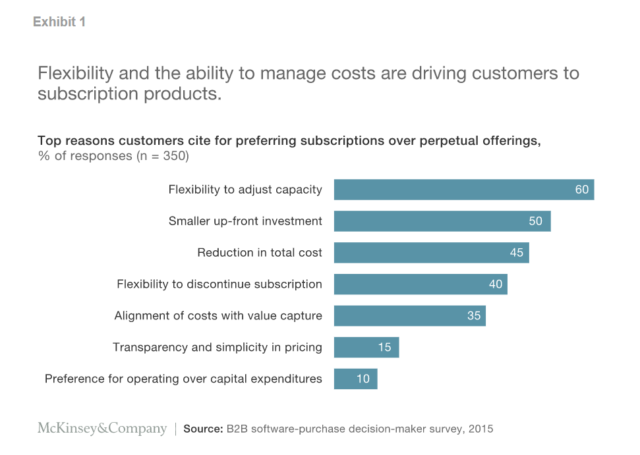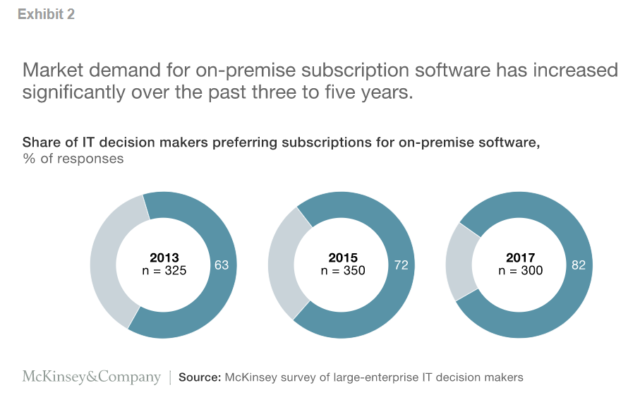Article republished with permission by McKinsey & Company.
The benefits of moving to flexible subscription pricing are closer than they appear, but common misconceptions hold companies back.
Migrating your business from an up-front to a recurring-revenue model can seem a daunting challenge that may take years to yield benefits. High-tech vendors often embark on massive projects requiring large investments in new offerings, such as multi-tenant cloud solutions or managed-service ones with multiyear lead times.
By focusing only on the long term, high-tech companies miss out on an opportunity to adapt their business model quickly to the new way customers like to purchase software and hardware: flexibly, without big up-front investments, and with costs reflecting the business value they derive.
Satisfying latent demand for flexible subscription pricing not only allows companies to capture significant additional lifetime value from existing customers but also unlocks previously untapped customer segments, which can include business units that prefer operating rather than capital expenses or companies whose cash constraints prevent them from making big advance investments (Exhibit 1). What’s more, companies that aren’t willing to make a full commitment but do value flexibility might be open to experimenting on a subscription basis. Further, subscription pricing helps high-tech vendors reduce the end-of-quarter “fire sales” that pervade up-front models.

Vendors that don’t adapt to this new market reality tend to see their traditional models come under increasing pressure. The demand for discounts on large up-front deals is rising as customers shift their software and hardware purchases from capital to operating expenses and as expectations for lower year-one costs for high-tech purchases rise. For all these reasons, the move to a subscription business model is no longer optional for most high-tech vendors.
Five Myths
The many successful business-model transitions in software, printing, and even aircraft engines show that there’s enough “case law” in the market to prove the value of subscription pricing.
Still, in our work with companies, we find that they often misunderstand critical aspects of the transition.
Here we dispel the five myths we observe most frequently.
Myth 1: You must move to the cloud to make the transition
Many companies use the terms “cloud” and “subscription” synonymously. However, distinguishing between the deployment model (cloud versus on premise) and the business model (perpetual versus subscription) is critical to seizing the recurring-revenue opportunity.
There is undoubtedly increasing demand for cloud solutions in the market, and a portfolio shift toward software as a service is the right long-term strategy for most software companies. But one particular kind of demand from customers outstrips even the demand for the cloud in most market segments: flexible subscription offerings.
For example, we find that the preference for on-premise software subscriptions has increased to 82 percent, from 63 percent, over the past several years (Exhibit 2). The simplicity and flexibility of the subscription model are the main reasons cited for this shift.

Through this lens, we see the cloud or hosting as just one of many ways to offer your customers a differentiated subscription offering. With on-premise subscriptions, you can also offer customers a stepping-stone for their eventual migration into the cloud—they can flexibly “remix” their on-premise subscriptions into cloud subscriptions, thus avoiding the conundrum of undepreciated perpetual licenses.
Finally, rolling out subscription pricing for on-premise offerings is easier than developing new cloud offerings: you can flip your existing price book to subscriptions in one or two quarters, not one or two years.
Myth 2: Subscription pricing is a zero-sum game between vendors and customers
It may seem counterintuitive that you can increase customer lifetime value through subscription pricing. After all, your customers can and will do the math on a subscription’s total cost of ownership and won’t always be willing to pay a significant premium over the expense of a perpetual license.
However, we have observed that there is almost always a window where the economics are favorable for both the vendor and the customer. The reason is simple: if you can prove the business value of your software to customers and ensure their success, churn will remain low and you will maintain customer loyalty for much longer than the initial business case of three to five years. They will gladly keep paying for business value, but not for what might become “shelfware.”
Striking the right balance between high subscription prices and high rates of adoption can substantially increase the customer lifetime value for the vendor. In addition, vendors can’t ignore the sales-efficiency gains resulting from subscription’s improved focus on true cross-sells and new functionality. Vendors also typically experience lower discounting pressures, and that preserves long-term value.
Myth 3: Offering both perpetual and subscription terms for the same product is too complex to manage
Companies executed some of the most successful transformations to the subscription model by phasing out perpetual offerings immediately or within a short time frame of six to 12 months, as Adobe and AspenTech did. While this approach can be hugely successful, it isn’t necessarily right for every transformation.
For B2B software vendors serving large enterprises, a hybrid model combining both perpetual and subscription offerings for a two- to three-year period can protect revenue and offer a safe transition. A still decisive—but not big-bang—transition allows vendors to capture the full benefit from customers that value the subscription model’s flexibility most.
Enabling your salespeople to position the optimal offering in such a hybrid world is critical. Giving sales reps a compensation model that’s neutral between perpetual and subscription products with the same lifetime value allows vendors to capture the full benefit of the latter.
Myth 4: The pace of your transition is limited by customer appetite for subscriptions
Before launching a subscription offering into the market, vendors often wonder if demand will be sufficient for a quick transition. In fact, our experience shows that, in almost all cases, demand far outstrips expectations, and the vendor’s internal constraints become the limiting factor for the pace of transition.
We typically find that the three critical success factors for a fast transition to the subscription model are the ability to bear the likely short-term cash outlays and revenue declines, to operationalize subscription offerings from opportunity to cash, and to give your sales force real incentives to sell subscriptions.
Finally, sometimes even simple accounting issues (such as vendor-specific objective-evidence treatment for licenses) hold companies back from a more aggressive move into subscriptions. Fortunately, the adoption of the new ASC 606 accounting standard now offers a natural window of opportunity to accelerate the transition.
If done right, the ramp-up can be quick: moving from single-digit to 30 percent and even considerably higher levels of subscription bookings in the transition’s first 12 months is feasible and even typical.
Myth 5: Your customers would never give up licenses they already own to migrate to subscriptions
It seems counterintuitive. Why would customers migrate their existing licenses to subscriptions? After all, they would be returning a product they already own just to rent it back from the vendor. In fact, we find that more than half of customers are open to doing just that, that a quarter have definitely decided to do so, and that almost 15 percent are already in transition (Exhibit 3).

The reason is simple: the migration gives them an opportunity to clean up years of complex perpetual contracts, to eliminate unused licenses, and to negotiate a subscription contract aligned with the true needs of the business.
A critical element of a successful transition is rightsizing customers. Vendors must carefully segment them by factors such as the level of new demand and the level of underutilized licenses and tailor the subscription’s value proposition to each segment.
With the right guardrails in place, the migration benefits both the vendor and its customers and accelerates future subscription upsells and cross-sells by avoiding the complexity of a hybrid licensing contract.
Seizing the subscription opportunity
The transition to subscription is becoming a well-trodden path, established through many successful case examples in the market. In our work with more than a dozen software and hardware companies that made this transition during the past 12 months, we have found that five core actions are critical to success:
- Move decisively into subscriptions, with ambitious adoption targets.
- Set your subscription price points thoughtfully to drive both adoption and lifetime value for each customer segment; protect those price points by integrating data-driven deal-pricing tools (for example, dynamic deal scoring) into the core commercial process.
- Create distinct subscription offerings so that customers don’t perceive the transition purely as a pricing change; differentiate your offerings through packaging, pricing architecture, customer-success services, and contractual flexibility.
- Take a segmented approach to migrating existing customers—proactively, selectively, or reactively—and support your sales force with dedicated teams to execute such migrations using appropriate guardrails.
- Treat the shift to a subscription business model as a cross-functional transformation affecting your full organization, including sales, marketing, services, product management, engineering, and finance.
Following these simple guidelines will put your recurring-revenue transformation on a path to success. Your customers, employees, and investors will thank you.
About the authors
Kevin Chao is a consultant in McKinsey’s Silicon Valley office; Michael Kiermaier is a partner in the Seattle office; Paul Roche is a senior partner in the Silicon Valley office; and Nikhil Sane is a consultant in the Atlanta office.
McKinsey & Company first published this article in December 2017, Subscription myth busters: What it takes to shift to a recurring-revenue model for hardware and software. Register to receive McKinsey’s latest thinking here.